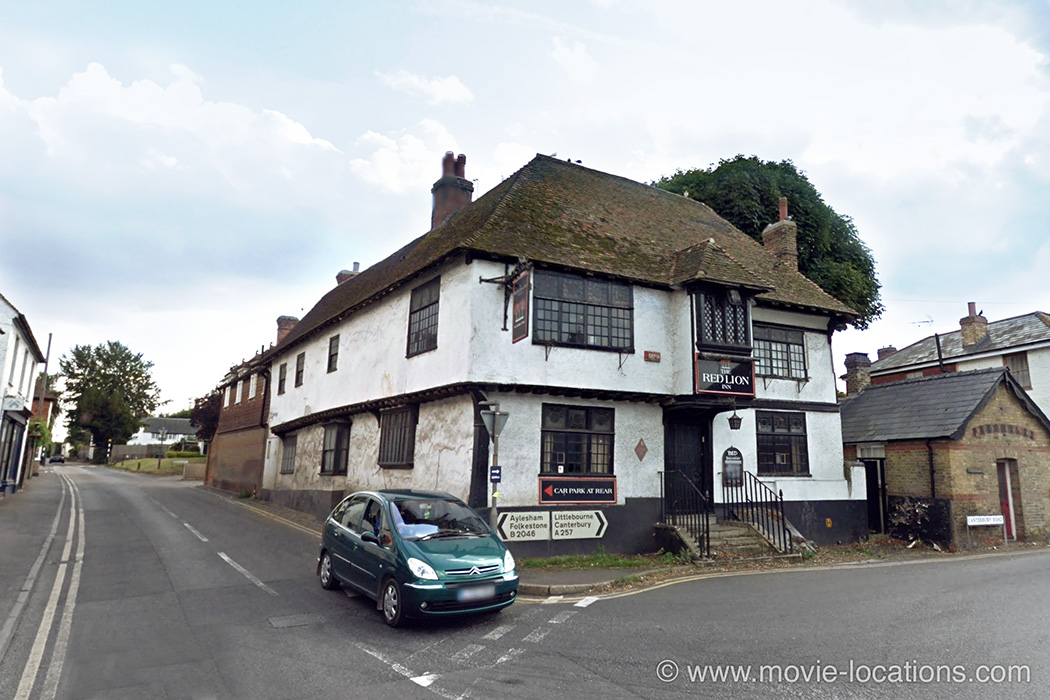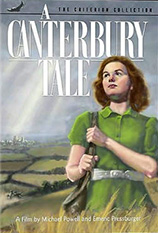A Canterbury Tale | 1944


- Locations |
- Kent
- DIRECTOR |
- Michael Powell;
- Emeric Pressburger
The pilgrimage to Canterbury in Kent became a tradition following the canonisation of Archbishop Thomas a Becket, who was recognised as a saint after being murdered in Canterbury Cathedral in 1170.
Racked by guilt for having (perhaps inadvertently) given the go-head for the killing, King Henry II made a pilgrimage from his court at Winchester to the Cathedral, which went on to become the holiest shrine in the country.
Countless common folk, looking for redemption, blessing or a VIP fast-track to heaven, followed the example of the King, earning the route the name of The Pilgrim’s Way.
In the late 14th Century, poet Geoffrey Chaucer wrote The Canterbury Tales, a collection of 24 stories supposedly told to pass the time on the journey. Mostly bawdy anecdotes, hey reveal the more earthly concerns of the devout Pilgrims. See Pier Paolo Pasolini’s 1972 film of The Canterbury Tales, part of the director’s Trilogy of Life, for his unashamedly libidinous version of the famous stories.
A Canterbury Tale, Michael Powell and Emeric Pressburger’s oblique exploration of Englishness, conjures up these medieval pilgrims in a brief prologue ended when an audacious jump-cut – which seemingly inspired Stanley Kubrick’s celebrated version in 2001: A Space Odyssey – makes the 600-year transition from a falcon in flight to a WWII fighter plane.
The film is set in the fictitious village of ‘Chillingbourne’, supposedly the last stop on the route before Canterbury, and takes place during the notorious blackout imposed during the war years, when no glimmer of light from streetlamps, car headlamps or uncurtained windows was allowed to give German night bombers a target to aim at.
In the pitch dark, all kinds of ne’er-do-wells thrived, including the film’s Glue Man, a mysterious prowler who’s bizarrely pouring glue onto the hair of unaccompanied women.
'Chillingbourne Railway Station', where US Sgt Bob Johnson (John Sweet) gets off prematurely and meets up with Land Girl Alison Smith (Sheila Sim) and Gibbs (Dennis Price), is Selling, on the Dover branch of the Chatham Main Line from London Victoria, and indeed one stop from Canterbury East.
As the three make their way through the darkness into the village, Alison becomes the latest victim of the Glue Man.
In this time of paranoia, the strangers are obliged to report to the Town Hall before finding a hotel.
The domain of local magistrate Thomas Colpeper (Eric Portman), this is the old Town Hall at Fordwich, a couple of miles northeast of Canterbury. It’s here, later on, that Colpeper delivers his lecture on the Pilgrim’s Way.
The new arrivals find lodgings and the local inn, ‘The Hand of Glory’.
On the A257, about seven miles east of Canterbury, stands the village of Wingham, where you’ll find the Grade II-listed Red Lion Inn on Canterbury Road at the High Street, which became 'The Hand of Glory' in the film.
Dating back to 1280, and mentioned in The Doomsday Book, this magnificent old inn seems now to be permanently closed. Despite a valiant attempt to save it, it has succumbed to 'developers' who want to develop it into private homes. Shame!
The street alongside the inn, which surprises Sgt Johnson with its narrowness, is Wingham High Street.
The Hand of Glory, by the way, is the dried and pickled hand of a man who has been hanged, often specified as being the left (Latin: sinister) hand.
A candle made of fat from the same corpse and attached to the fingers was supposed to endow the holder with extraordinary powers. You can see the Hand being used in The Wicker Man, to get Sgt Howie to sleep soundly.
First thing next morning, the determined Alison is already getting a broken cartwheel fixed at the local wheelwright’s. The blacksmith's forge stood in the village of Shottenden, six miles west of Canterbury, off the A28.
Returning to the centre of the village, she gives a lift to Sgt Johnson, who admires the weatherboarding of the huge old watermill building, which stands relatively unchanged in the village of Wickhambreaux, just northwest of Wingham.
The grand house nearby, which turns out to be that of Colpeper, is the Grade II-listed Wickhambreaux Court on The Green.
The working-out of the plot sees the three new arrivals, along with Colpeper, taking the same train from 'Chillingbourne’ to Canterbury, where Colpeper takes his leave of them alongside the imposing double-towered gateway of Westgate.
Just a little to the north, One Pound Lane, now a bar, becomes the ‘police station’, where Gibbs attempts to report the identity of the Glue Man but is told the Superintendent has left for the cathedral.
Sgt Johnson enjoys a cup of English tea with his GI chum and receives his particular ‘blessing’ in the ‘Cathedral Tea Rooms, now the Cathedral Gate Hotel, 36 Burgate, alongside the Cathedral’s imposing entrance.
The exterior of Canterbury Cathedral is real enough, but the organ sound, when cinema organist Gibbs realises his dream of blasting out Bach’s Toccata and Fugue, is that of St Alban’s Cathedral in Hertfordshire (Canterbury’s having been dismantled for wartime safety reasons).
The Cathedral’s nave had to be reconstructed in the studio at the old Denham Studios, also in Hertfordshire, as the irreplaceable stained glass windows at Canterbury Cathedral had been boarded up – as you can plainly see in the exterior shots.





